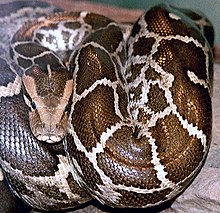Pythonidae
| Pythonidae | |
|---|---|
 |
|
| Indian python, Python molurus | |
| Scientific classification | |
| Kingdom: | Animalia |
| Phylum: | Chordata |
| Class: | Reptilia |
| Order: | Squamata |
| Suborder: | Serpentes |
| Infraorder: | Alethinophidia |
| Family: |
Pythonidae Fitzinger, 1826 |
| Synonyms | |
|
|
The Pythonidae, commonly known simply as pythons, from the Greek word python (πυθων), are a family of nonvenomous snakes found in Africa, Asia, and Australia. Among its members are some of the largest snakes in the world. Eight genera and 31 species are currently recognized.
Pythons are found in sub-Saharan Africa, Nepal, India, Sri Lanka, Burma, southern China, Southeast Asia, and from the Philippines southeast through Indonesia to New Guinea and Australia.
In the United States, an introduced population of Burmese pythons, Python molurus bivittatus, has existed as an invasive species in the Everglades National Park since the late 1990s.
Many species have been hunted aggressively, which has decimated some, such as the Indian python, Python molurus.
Most members of this family are ambush predators, in that they typically remain motionless in a camouflaged position, and then strike suddenly at passing prey. They will generally not attack humans unless startled or provoked, although females protecting their eggs can be aggressive. Reports of attacks on human beings were once more common in South and Southeast Asia, but are now quite rare.
Pythons use their sharp, backward-curving teeth, four rows in the upper jaw, two in the lower, to grasp prey which is then killed by constriction; after an animal has been grasped to restrain it, the python quickly wraps a number of coils around it. Death occurs primarily by asphyxiation; some research has suggested that pressures produced during constriction may cause cardiac arrest by interfering with blood flow, but this hypothesis has not been confirmed.
...
Wikipedia
